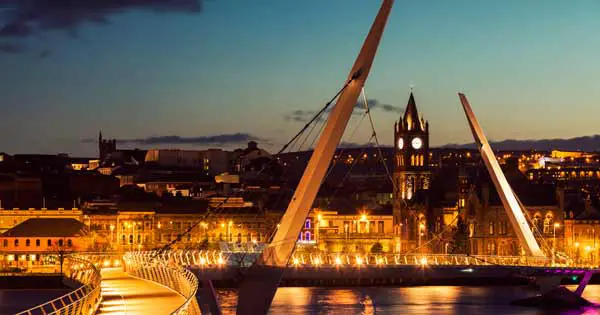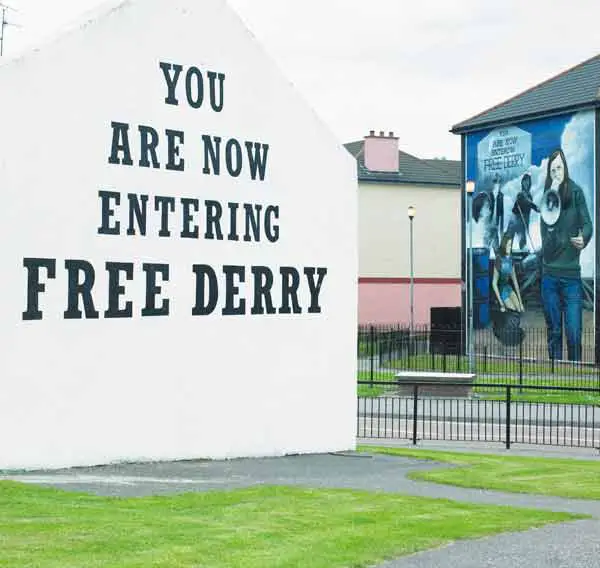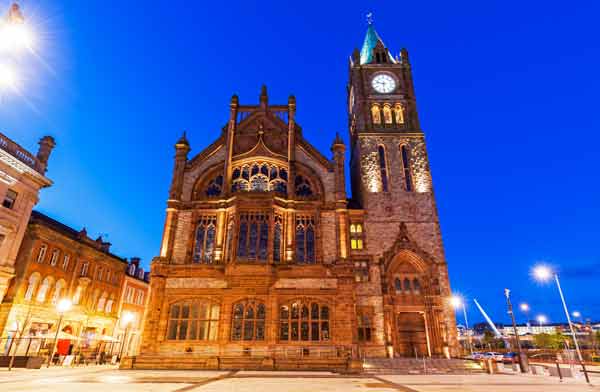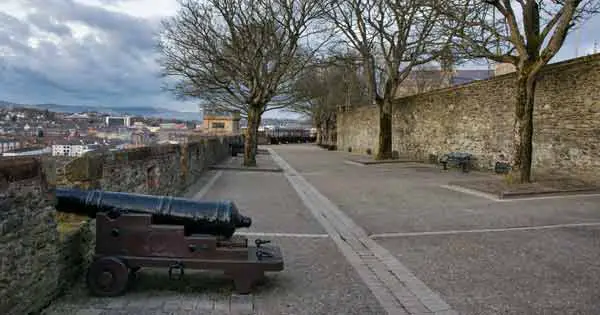Derry has such a long and eventful history involving Catholics and Protestants that it’s ended up having two names. Traditionally, Irish Catholics who wish to retain the city’s Irish name refer to it as Derry, while British Protestants know the city as Londonderry.
Derry (or Londonderry) is the second biggest city in Northern Ireland and is the fourth largest in the island of Ireland.
Londonderry has been the official name since 1613, when King James I granted the city a Royal Charter. However, Derry is the more commonly used name around the world and by the citizens themselves, particularly Catholics but also many Protestants as well.
Derry is the only city in Ireland that is still completely within city walls.
People first settled there on the banks of the River Foyle as early as the 6th century. A monastery was founded by St Columbia. It is thought that people had lived in the vicinity for thousands of years. However, the 6th century monastery was the earliest formal recording of a settlement in what was to become Derry.
The town was fiercely fought over during the 17th century, particularly between English invaders and Irish natives. Having come under the control of the English Tudors, Derry was destroyed by Irish chieftain Sir Cahir O’Doherty in 1608.
English soldier and statesman Sir Henry Docwra had made strides in developing the town and was known to some as the ‘founder of Derry’.
Walking tour of the murals
Like many places in Northern Ireland, areas of Derry have been decorated with political murals. The Catholic and Protestant communities have had severe conflicts with one another in the past. As they both have to share the city the murals became an important outlet for artists expressing the feeling of their side.
Thankfully, the conflict is largely in the past as the people in Northern Irish cities continue to strive to live together peacefully.
The murals are striking and though-provoking pieces of artwork that give an important insight into the depth of feeling within the communities, both to their commitment to their own cause and history, and towards the other community.
Tourists can take a tour of the murals with guides who will help them better understand the relevance of the images. Some tours are conducted by the artists themselves.
Free Derry museum
The Free Derry museum tells the story of the city in the 1960s and 70s. It was a significant era in the history of Derry, with the Civil Rights Movement of the 1960s and the Troubles of the 1970s. Many events took place during this time such as Bloody Sunday, the Battle of the Bogside, Internment and the Free Derry campaign.
The museum is located near Rossville Park, which is central to the location of many of the events. It contains over 25,000 items that help to tell the story of this period. Many of the pieces were donated to the museum by local residents.
Free Derry Corner
Free Derry Corner is a historical landmark in the Bogside area which is outside the city walls. There is a free standing gable wall with the slogan ‘You Are Now Entering Free Derry’ painted over a white background.
The slogan was first painted in 1969 by local activist John Casey. It was first painted on the side wall of a house at the end of a row of terraced houses. There are also a number of murals in the area.

The houses were later demolished but the wall was left standing and became known as Free Derry Corner. The Corner includes a memorial to those who lost their lives in the 1981 hunger strikes. There is also a memorial to the members of the Provisional IRA’s Derry Brigade who died engaging in paramilitary activity.
Free Derry Corner and the surrounding area was where the Battle of the Bogside took place in 1969. It was also the scene of Bloody Sunday three years later.
Peace Bridge
The Peace Bridge crosses the River Foyle and connects the ‘Cityside’ area which is largely Nationalist and the ‘Waterside’ area which is mostly Unionist.
The connection is deeply symbolic as the communities have had a long and troubled history. The bridge was opened in 2011.
It is a sweeping elegant bridge which is for cyclists and pedestrians. More on the Peace Bridge

Tower Museum
A short walk away from the Peace Bridge is the award winning Tower Museum that tells the story of Derry/Londonderry.
The story goes back to Monastic times all the way through the Plantations of the 17th century, the Siege of Derry, the Civil Rights Movement, The Troubles and up until the present day.
It also includes an exhibition about a shipwreck from the Spanish Armada. It tells the story of one of the biggest ships of the Spanish fleet – La Trinidad Valencera, which sunk in the waters near Donegal and wasn’t found for 400 years. There are a number of temporary exhibitions throughout the year.
Guildhall
Guildhall is the meeting place for elected members of Derry City Council. It is a building with many stories to tell.
It was built in 1890 by ‘The Honourable Irish Society’ which was an organisation set up by the Royal Charter to colonise Co Londonderry during the Plantation of Ulster.

The original Guildhall was burned down during Victorian Times and the site became Guildhall Square. The current building is at the head of the square. It was damaged by a fire again in 1908, and rebuilt and renovated in 1912.
In 1972, during The Troubles, Guildhall was damaged by two bombs. Again, the building was restored and re-opened in 1977. A recent 2010 restoration costing £8m has made Guildhall one of Derry’s major tourist attractions.
A number of events take place in the building throughout the year. The Saville Inquiry, which looked into the events of Bloody Sunday was a notable investigation that was carried out at Guildhall. It was also the staging area for the visit of US President Bill Clinton in 1995.
Bloody Sunday memorial
The Bloody Sunday Memorial is a granite obelisk that commemorates the 14 people, many of whom were teenagers, who were killed by British paratroopers on Bloody Sunday.
The memorial is located in the Bogside area, outside the city walls. Bogside is a largely Catholic, Nationalist area and was the scene of a number of incidents during The Troubles.
Bloody Sunday was on January 30th 1972. British paratroopers in Derry shot 26 unarmed civilians who were taking part in a protest march against Internment. Many of the people shot were either running away from the soldiers or tending to those who were wounded on the floor. Thirteen were killed, and another died four months later due to injuries sustained during the attack.
The Memorial is in the Free Derry area of Bogside, where the events of Bloody Sunday took place. It features the names of all the people killed on Bloody Sunday. Residents still regularly place wreaths at the base of the memorial.
Derry City Walls
The Walls that surround Derry are an attraction in themselves. They were built between 1614 and 1619 and are almost perfectly preserved to this day.
They were built by the Irish Society who despite their name were actually mainly London businessmen. It was their job to defend Derry from Irish rebels following the Plantation of Derry under King James I.
There were sieges in both 1641 and 1649 but the walls stood strong and were not breached by the rebels. Today they are some of the oldest and most impressive examples of city walls in Europe.

Hands Across the Divide statue
The Hands Across the Divide statue is a sculpture of two men reaching out their hands to each other in friendship. It is a symbol of peace in a city that has spent such a long time divided.
It is situated just west of Craigavon Bridge and the arms of the two figures reach over passers-by who enter the bridge.
It was created by Maurice Harron and unveiled in 1992 to mark the 20 year anniversary of the Bloody Sunday massacre.
Grianan of Aileach
Grianan of Aileach is a collection of historic structures including a stone fort that is thought to have been built by the powerful O’Neill dynasty in the 7th century.
It is thought to have been the seat of the Kings of Ailech – the northern O’Neills – and is one of the royal sites of Gaelic Ireland.
The stone fort is a formidable structure. It stands at 16 ft tall and the walls are 15 ft wide. The fort contains terraces and passages within the walls.
It is thought that the fort was attacked by the O’Briens and nearly destroyed in 1101.
Although it was built by the O’Neills there is evidence to suggest that the site had been used for centuries earlier.
Legend says that it was used by the mythical Tuatha de Danann who invaded Ireland in 1,700 BC, long before the Celts had ever set foot on the island.
They built forts on strategic hills and worshipped Dagda – the Good God. They are said to have built the fort after an order from Dagda who wanted a burial monument for his son who had passed away.
St Patrick is also said to have visited the fort and baptised the local Chieftain named Eoghan in the 5th century.
The fort underwent a huge refurbishment in 1870 and today it is a National Monument and attracts tourists from all over Ireland and across the world.
It stands 250 ft above sea level and is actually across the north/south border in Donegal, Republic of Ireland. However, Derry is the nearest city and is only a short distance away.
Landmark buildings
There are two Cathedrals in Derry – the Roman Catholic St Eugene’s and the Church of Ireland St Columb’s.
St Eugene’s Cathedral was built over 24 years from 1849 to 1873. It was only possible to build following the 1829 Roman Catholic Relief Act which gave more rights to Catholics in Ireland.
It was designed by J.J. McCarthy, who had created many of Ireland’s Cathedrals. While it officially opened in 1873, it wasn’t fully completed for another 30 years due to a lack of funds.
Stained glass replaced plain glass in the 1890s, while it wasn’t until 1903 that the spire and bell tower were finally complete. The funding came not just from Derry but all over Ireland and even from America.
St Eugene’s underwent extensive renovation in the 1980s as it was in desperate need of repair. It was refurbished again in 2015.
St Columb’s Cathedral is dedicated to the Irish monk St Columbus and is the first non-Catholic Cathedral to be built in Europe. The current Cathedral was built in 1633, after the original had been destroyed during the Nine Years War.
The current structure contains a small square stone from the original. The stone is in the porch of the Cathedral and has the inscription ‘In Templo Vervs Devs Est Verec Colendvs’ – which means ‘The True God is in His Temple and is to be truly worshipped’.
St Columb’s contains many portraits of William of Orange as well the original keys to the city. There are also several documents that date back to the Siege of Derry of 1689.
Prehan House
Another prominent building is the 18th-century Irish Georgian Prehan House. It has been listed a Grade A Building of National Importance.
It was built in 1740 for Andrew Knox, the MP for Donegal. It remained in the Knox family for 170 years.
Visitors can take history tours of the house where they will learn some of the interesting stories attached to it.
It is the scene of a famous Irish love story – the legend of Half-Hung MacNaghten. John MacNaghten was a murderous Anglo-Irish landowner.
While he wasn’t a rich man, he had a comfortable lifestyle and got a job as a tax collector. However, he was a gambling addict and lost £800 of the King’s money in 1760. Everything he had was seized and he was left penniless.
MacNaghten visited his childhood friend Andrew Knox at Prehan House. Knox helped MacNaghten through his addiction, but MacNaghten began a relationship with Knox’s 15-year-old daughter May-Ann.
Mary-Ann was wealthy and was set to inherit £6,000. MacNaghten decided he wanted to marry her to help fund his gambling.
Knox was furious and attempted to take his daughter to Dublin to escape MacNaghten. However, MacNaghten ambushed the coach and attempted to abduct Mary-Ann. In the struggle he accidently shot and killed her.
He was sentenced to death by hanging. However, when the time came on 16 December 1761, he leapt from the gallows with his head in the noose and broke the rope.
He had the crowd on his side who sympathised with his grief over the death of the woman he loved. They believed that God had intervened in saving him and despite the fact he had been a tax collector, they liked him for his rebellious attitude towards the wealthy landowners.
Despite the good will from the crowd, MacNaghten didn’t want to be known as ‘Half-hanged MacNaghten’ and he was hanged for a second time – this time successfully.
Shopping
Shoppers might be interested to know that the oldest department store in Ireland is in Derry. Austin’s is in the Diamond area of the city and sells clothing and homeware. It was established in 1830. The impressive building has an Edwardian style exterior and is five stories high, covering 25,000 square feet.
Elsewhere, there is plenty to keep shopaholics busy with the Folyleside shopping centre having a reputation as the biggest and best in Northern Ireland.
There is also the Richmond Shopping centre, Quayside Centre and Craft Village.
Derry nightlife
When the time comes to let your hair down after a busy day of sightseeing there is plenty to do in Derry.
Fans of traditional Irish music could head to bars such as Peardar O’Donnell where they have three bars with live bands on most nights. Bennigan’s Bar is known for its live jazz performances.
The Nerve Centre is a great place for creative types. It hosts live music gigs and also includes a cinema that shows independent films.
Café Soul is another great place to get a meal and see some live music. It has hosted acoustic artists at the Foyle Folk Festival and there are often impromptu performances at the venue.
Sports fans should head to the Metro Bar where there is usually a big game on the TV screens and there are regular pool tournaments.
Theatre goers will want to check out the Millennium Forum and the Playhouse Theatre. These venues host a variety of events ranging from plays, music, dance, exhibitions and stand-up comedy.
There are dozens of great places to go for a nice meal in Derry. All food tastes are catered for somewhere in the city. Everything from Indian to Italian, from Chinese to Lebanese from American style burgers to traditional Irish dishes.
Ireland Calling Videos
Check out the Ireland Calling YouTube Channel for more great videos like these